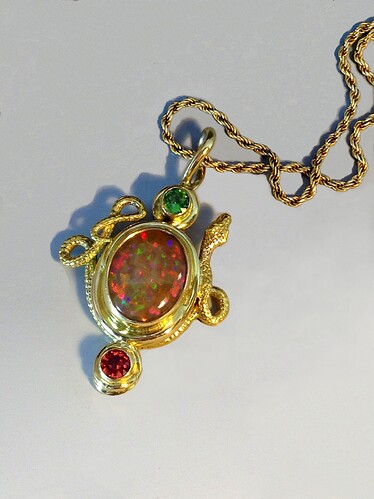Hi Jackie
I will ignore your ad hominem attack, other than to say that I do not
dismiss CAD/CAM at all, (where did that come from?) and I am not very
prejudiced, nor totally ignorant.
And I bet you have NEVER touched metal clay, am I right?
Actually, you are wrong.
I first read about PMC in a quarterly magazine called Aurum (I
think) and that it was being developed by Mitsubishi in the early
1990’s.
I was most intrigued.
So much so that I tried phoning Mitsubishi directly but the language
barrier proved insurmountable in the pre-internet days.
Inlay into stones was my first focus. I imagined it to be much like
a mercury amalgam without the toxicity.
I purchased some in about '95 and ran a bunch of experiments in my
workshop and at the end I came to the conclusion that while it was a
nice technology, I could find no practical use for it.
There was no actual medium that it replaced that was not already
cheaply available.
The main drawback was it’s massive shrinkage, porosity, and that the
metal’s apparent lack of density caused it to be weak.
The electrical cost also was a factor.
Having to run an oven at burnout temperatures to sinter a piece
seemed very inefficient and wasteful to me.
Fast forward to today and I see that the product has been refined to
an extent, but still has the same drawbacks I mentioned earlier.
The next ten years also produced a wave of so called artists who
produced badly made metal objects loosely called jewellery.
The new thinking was that there was no more a need to learn proper
metal working, but armed with an oven, a few spatulas and PMC, the
jewellery world was conquered.
This proved to be a fallacy and once the dust had settled, the rise
of the “certified instructor” took place.
This term gave gravitas to PMC, because if you were taught by some
one who was certified, then by implication you also were licensed to
work in PMC and therefore you would be making good jewellery.
Sadly, this is not true.
Going to the pretentiously titled ‘Metal Clay Masters Register’
website and reading about the costs and efforts involved to get
yourself ‘registered’ reminds me a bit of a pyramid scheme crossed
with Scientology.
And to add insult to injury, all the pieces that are shown there are
not even remotely approaching the ‘master’ level.
PMC is not a completely bad thing, though.
What PMC has done is to introduce many people to the art of
jewellery making.
Once the person who starts with PMC realizes that the metal objects
that they make are unsalable at a professional level, often they are
inspired to learn the correct methodology and so expand their skill
set.
I am sure that on a global scale, PMC has caused more people to
enter the jewellery field than any other product in recent times.
And that is certainly a good thing.
But PMC should only be regarded as the first level of your learning
process.
Not the final destination.
The PMC industry has ballooned into an accessory supply industry,
where the most money is made selling the raw product.
Everybody ignores the fact that the bar has been lowered and that
working solely in PMC is an evolutionary dead end.
The fact remains that using a carving wax and then having it cast is
far, far cheaper, much more simple and versatile and can produce a
product that, unlike PMC, can be sold professionally.
So Jackie, you are welcome to go to my website (meevis.com) to judge
my level of ignorance, and in turn, perhaps you could show me some of
the work that you have done in metal clay that is indistinguishable
from traditional metalworking.
Hans
http://www.meevis.com
http://hansmeevis.blogspot.com

